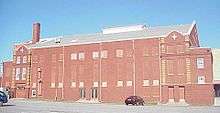Brady Theater
 | |
| Former names |
Tulsa Convention Hall Tulsa Municipal Theater |
|---|---|
| Address |
105 W. Brady St. Tulsa, Oklahoma United States |
| Owner | Peter Mayo |
| Capacity | 4,200 |
| Opened | October 22, 1914 [1] |
| Website | |
|
Convention Hall | |
| Coordinates | 36°9′28.51″N 95°59′42.53″W / 36.1579194°N 95.9951472°WCoordinates: 36°9′28.51″N 95°59′42.53″W / 36.1579194°N 95.9951472°W |
| Architect | Curtin |
| NRHP Reference # | 79002028 [2] |
| Added to NRHP | August 29, 1979 |
Brady Theater (formerly Tulsa Convention Hall and Tulsa Municipal Theater) is a theater and convention hall located in Tulsa, Oklahoma. It was originally completed in 1914 and remodeled in 1930 and 1952. The building was used as a detention center during the 1921 Tulsa Race Riot.[3] It is listed on the National Register of Historic Places and remains in use as a theater today.
History
The Brady Theater has served Tulsa as a public assembly facility since its completion in 1914. Located at the corner of W. Brady Street and N. Boulder Avenue, it was built between 1912 and 1914 by The City of Tulsa upon the approval of a $125,000 bond issue. The theater was originally designed as a municipal auditorium and convention hall by the architectural firm of Rose and Peterson of Kansas City, Kansas. From 1914 to 1952, the building was known as Convention Hall. When the facility officially opened, it was billed as the largest hall between Kansas City and Houston, Texas.[4] Another source claims it was one of only 16 theaters in the U. S. equipped to host a full Metropolitan Opera production.[5]
According to a local legend, the building is haunted by the ghost of Enrico Caruso, who performed there in 1920 and reportedly caught the cold that led to his death of pleurisy in 1921.[6]
Because of its size and proximity to Greenwood the building was used temporarily to detain black men rounded up by the National Guard during the 1921 Race Riot.[3]
The venue has been given several nicknames by locals, including "The Miracle on Brady Street," "Old Lady of Brady" and the "Theater That Wouldn't Die."[1]
Description
Located at 105 West Brady Street, the building is four stories tall, occupying an area of 130 feet by 160 feet. It was designed with a seating capacity for 4,200 people (including 1,300 in the balcony). The stage was 70 feet wide and 40 feet deep, and slopes 13 feet from back to front. According to the Tulsa Preservation Commission, the building also contained the only municipally owned pipe organ west of the Allegheny Mountains.[4]
1930 Renovation
In 1930, world-renowned architect Bruce Goff was hired as designer of a major overhaul of the interior. He was given thirty days to plan the transformation of the barn-like space into an elegant showplace suitable for a city that was becoming known as "The Oil Capital of the World." The Art Deco style remodeling included draperies and seats, vertical wall panels of white plaster decorated with thin gold dividers, gilded air conditioning grilles, and acoustic ceiling tiles painted green, blue, white, and gold. Five massive green and white pendant light fixtures were installed centrally in the auditorium.[4]
1952 Additions
In 1952, additions were constructed at the front and rear of the original structure. Upper and lower lobbies were added and the building was renamed Tulsa Municipal Theater. The architectural design at the time was referred to as Western Classic Revival. In 1978, The City of Tulsa sold the building by sealed bid to local entrepreneur, Peter Mayo, who has owned it since. In 1979, the building was listed on the National Register of Historic Places. The building was supplanted in 1977 as the city's municipal auditorium by construction of the more modern Tulsa Performing Arts Center a few blocks southeast of the Brady's location. Renamed simply The Brady Theater, and affectionately known as "The Old Lady on Brady," it continues to operate as a venue for a wide variety of concerts and theatrical productions.[4]
NRHP listing
Brady Theater was listed in the National Register of Historic Places on August 29, 1979. It was listed under National Register Criterion A and its NRIS number is 79002028.[4]
References
- 1 2 "Brady Theater Celebrates Anniversary." September 8, 1989. Accessed October 4, 2015.
- ↑ National Park Service (2007-01-23). "National Register Information System". National Register of Historic Places. National Park Service.
- 1 2 "The Tulsa Race Riot of 1921"
- 1 2 3 4 5 Tulsa Preservation Commission Website. "Tulsa Convention Hall." Archived February 12, 2007, at the Wayback Machine.
- ↑ Davis, Kirby Lee. "These Walls: Brady Theater in Tulsa" The Journal Record August 7, 2009. Retrieved July 16, 2011.
- ↑ Jenkins, Joy. "Ghost Town: Brady Theater." Tulsa People. October 2010. Accessed October 4, 2015.